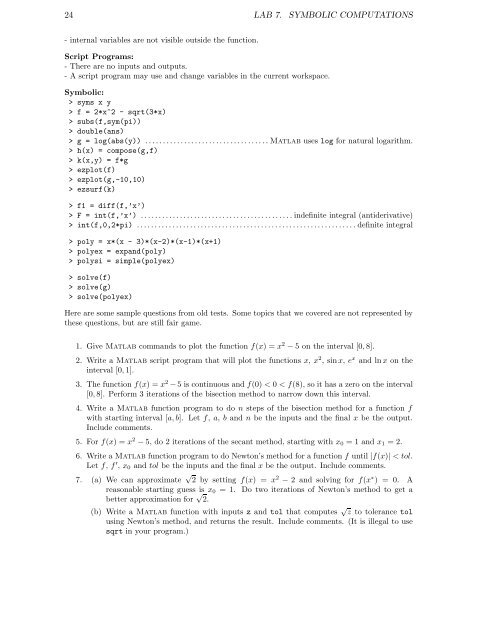Introduction to Numerical Math and Matlab ... - Ohio University
Introduction to Numerical Math and Matlab ... - Ohio University
Introduction to Numerical Math and Matlab ... - Ohio University
You also want an ePaper? Increase the reach of your titles
YUMPU automatically turns print PDFs into web optimized ePapers that Google loves.
24 LAB 7. SYMBOLIC COMPUTATIONS<br />
- internal variables are not visible outside the function.<br />
Script Programs:<br />
- There are no inputs <strong>and</strong> outputs.<br />
- A script program may use <strong>and</strong> change variables in the current workspace.<br />
Symbolic:<br />
> syms x y<br />
> f = 2*x^2 - sqrt(3*x)<br />
> subs(f,sym(pi))<br />
> double(ans)<br />
> g = log(abs(y)) . .................................. <strong>Matlab</strong> uses log for natural logarithm.<br />
> h(x) = compose(g,f)<br />
> k(x,y) = f*g<br />
> ezplot(f)<br />
> ezplot(g,-10,10)<br />
> ezsurf(k)<br />
> f1 = diff(f,’x’)<br />
> F = int(f,’x’) . .......................................... indefinite integral (antiderivative)<br />
> int(f,0,2*pi) .............................................................. definite integral<br />
> poly = x*(x - 3)*(x-2)*(x-1)*(x+1)<br />
> polyex = exp<strong>and</strong>(poly)<br />
> polysi = simple(polyex)<br />
> solve(f)<br />
> solve(g)<br />
> solve(polyex)<br />
Here are some sample questions from old tests. Some <strong>to</strong>pics that we covered are not represented by<br />
these questions, but are still fair game.<br />
1. Give <strong>Matlab</strong> comm<strong>and</strong>s <strong>to</strong> plot the function f(x) = x 2 − 5 on the interval [0, 8].<br />
2. Write a <strong>Matlab</strong> script program that will plot the functions x, x 2 , sinx, e x <strong>and</strong> lnx on the<br />
interval [0, 1].<br />
3. The function f(x) = x 2 −5 is continuous <strong>and</strong> f(0) < 0 < f(8), so it has a zero on the interval<br />
[0, 8]. Perform 3 iterations of the bisection method <strong>to</strong> narrow down this interval.<br />
4. Write a <strong>Matlab</strong> function program <strong>to</strong> do n steps of the bisection method for a function f<br />
with starting interval [a, b]. Let f, a, b <strong>and</strong> n be the inputs <strong>and</strong> the final x be the output.<br />
Include comments.<br />
5. For f(x) = x 2 − 5, do 2 iterations of the secant method, starting with x 0 = 1 <strong>and</strong> x 1 = 2.<br />
6. Write a <strong>Matlab</strong> function program <strong>to</strong> do New<strong>to</strong>n’s method for a function f until |f(x)| < <strong>to</strong>l.<br />
Let f, f ′ , x 0 <strong>and</strong> <strong>to</strong>l be the inputs <strong>and</strong> the final x be the output. Include comments.<br />
7. (a) We can approximate √ 2 by setting f(x) = x 2 − 2 <strong>and</strong> solving for f(x ∗ ) = 0. A<br />
reasonable starting guess is x 0 = 1. Do two iterations of New<strong>to</strong>n’s method <strong>to</strong> get a<br />
better approximation for √ 2.<br />
(b) Write a <strong>Matlab</strong> function with inputs z <strong>and</strong> <strong>to</strong>l that computes √ z <strong>to</strong> <strong>to</strong>lerance <strong>to</strong>l<br />
using New<strong>to</strong>n’s method, <strong>and</strong> returns the result. Include comments. (It is illegal <strong>to</strong> use<br />
sqrt in your program.)
















